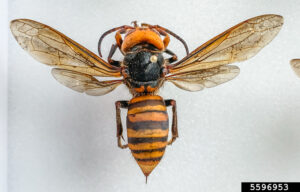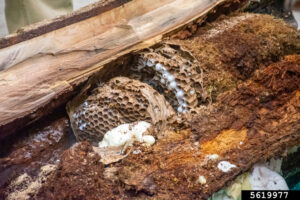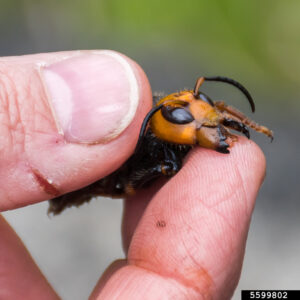NORTHERN GIANT HORNET (Vespa mandarinia)
FOUND IN B.C.? No.
Identification

Adult worker northern giant hornet. Photo credit: Karla Salp, Washington State Department of Agriculture, Bugwood.org.
The northern giant hornet is the world’s largest hornet. Worker northern giant hornets are 2.5 – 3 centimetres in length, while the queen can be up to 5 centimetres in body length and have a wingspan of 7.5 centimetres. They have a shield shaped head that is bright orange-yellow, with large jaws and fully black eyes. The thorax of the northern giant hornet, where the legs meet the body, is dark brown or black, and the abdomen is alternately striped orange-yellow and black-brown. The stinger region is yellow, and their wings are tinted dark brown. Northern giant hornets are on the Provincial EDRR (early detection rapid response) species list. There are several native insects that have resemblances to the northern giant hornet, but none are as large or have the same pattern on their body.

Comparison between northern giant hornet (left) and the native bald faced hornet (right). Photo credit: Karla Salp, Washington State Department of Agriculture, Bugwood.org.
The ministry of Agriculture, Food, and Fisheries factsheet compares the northern giant hornet with some native look a like species.
Life Cycle
The northern giant hornet establishes nests in the spring. Queen hornets will overwinter underground alone, and then emerge in late April to early May to get to work building a nest and laying eggs. The first workers will emerge around June, and their jobs include foraging for food and expanding the nest. The queen will continue to lay eggs, and by August to October, queen hornets and males are matured and mating takes place. During this time, the workers aggressively forage for food to provide for the expanding colony. At this point, the queen who started the nest will die, worker hornets are no longer emerging, and the nest begins to die off. Once the queens have mated, they will retreat underground for the winter and the cycle repeats in the spring.

Northern giant hornet nest showing multiple life stages. Photo credit: Karla Salp, Washington State Department of Agriculture, Bugwood.org.
Ecology
These hornets prefer low altitude forests and mountains, and create underground nests by digging, utilizing existing tunnels, or using spaces by tree roots and stumps. It can be difficult to detect hornets early, as they are disguised in their underground nests. Northern giant hornets will forage up to 8 kilometres from their nest, and feed on other insects such as butterflies, moths, dragonflies, bees, and wasps. They are a threat to honeybee hives, and have a very aggressive predation style that can completely destroy other bee and wasp colonies. Northern giant hornets will mark targeted hives with pheromones, which a larger group of hornets will follow and attack. Adult northern giant hornets will kill insects to provide food for the young in their nest. These hornets are not interested in humans or other animals, and will only sting humans if their nest is disturbed or threatened. Northern giant hornets have been referred to as “murder hornets”, which comes from their aggressive behaviours towards other insects, not towards humans.

Queen northern giant hornet. Photo credit: Karla Salp, Washington State Department of Agriculture, Bugwood.org.
Introduction and Spread
Northern giant hornets are native to south and east Asia, and were most likely transported to North America on container ships, in packing material, or through imported garden pots. These hornets are not currently established in BC, but they have been previously detected. The first sighting was in Nanaimo, on Vancouver Island, in 2019, where a single nest was found and subsequently destroyed by BC government officials, the Canadian Food Inspection Agency, and local beekeepers. In 2020, six specimens were found in the Fraser Valley, but all were destroyed through vigilant monitoring.
Impacts
Northern giant hornets pose a serious threat to beekeeping and pollination, which impacts agriculture. In North America, these hornets feed mainly on native insects that play an important role in pollinating native plants. These native insects have not evolved to have defence mechanisms against northern giant hornets, and their populations would drastically decline by being predated on. This would reduce crop yields and impact the food production industry. Northern giant hornets also impact recreation, as they are territorial and will defend their nests if threatened. They can deliver a painful sting, and are capable of stinging multiple times, threatening human health.

Photo sourced from: https://www.cheknews.ca/nanaimo-beekeepers-take-down-nest-of-giant-asian-hornets-606215/
What Can We Do?
The best approach to managing the threat of northern giant hornets is to prevent them from establishing in BC. We can do this by reporting any sightings right away to CSISS on our website, to the Province with their online form or on the Report Invasive mobile app. If you think you have found a northern giant hornet nest, do not try to remove it yourself, as this could be dangerous. First report the sighting, and seek professional help in removing the nest. The Washington State Department of Agriculture has a virtual interactive map to record sightings of the northern giant hornet in Canada and the USA.
Literature and Resources:
- https://bcinvasives.ca/invasives/northern-giant-hornet/#:~:text=Northern%20giant%20hornets%20are%20the,tree%20stumps%20of%20forested%20areas.
- https://agr.wa.gov/departments/insects-pests-and-weeds/insects/hornets/reported-sightings
- https://www.invasivespeciescentre.ca/murder-hornets-whats-all-the-buzz-about/
- https://www2.gov.bc.ca/assets/gov/farming-natural-resources-and-industry/agriculture-and-seafood/animal-and-crops/animal-production/bee-assets/pest_alert_asian_giant_hornet.pdf
- https://www.researchgate.net/publication/343537117_THE_ASIAN_GIANT_HORNET-WHAT_THE_PUBLIC_AND_BEEKEEPERS_NEED_TO_KNOW-FS347E
- https://www.invasivespeciescentre.ca/invasive-species/meet-the-species/invasive-insects/northern-giant-hornet/